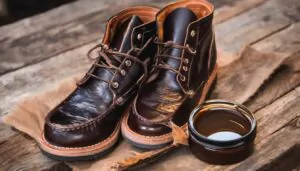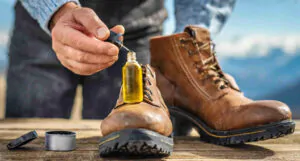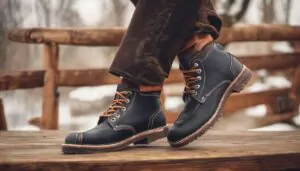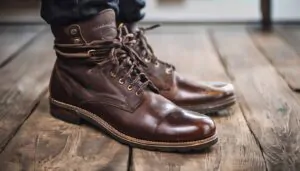MINK OIL BOOT CARE: HOW TO APPLY CORRECTLY
Did you know that properly conditioning and waterproofing your boots can significantly extend their lifespan? One effective method to achieve this is by using mink oil. Not only does mink oil soften and condition leather, but it also provides excellent protection against water damage. In this article, I will guide you through step-by-step instructions on how to correctly use mink oil on your boots, ensuring they stay in optimal condition for years to come.
Authors Recommended: How To Stop Feet From Sliding Forward In Heels
BENEFITS OF MINK OIL FOR LEATHER BOOTS

Before diving into the application process, it’s essential to understand the benefits of using mink oil on leather boots. Mink oil offers numerous advantages for the care and maintenance of your boots, ensuring their longevity and protecting them from everyday wear and tear.
Softening and Conditioning
Mink oil is renowned for its exceptional softening and conditioning properties. When applied to leather boots, it penetrates the material, moisturizing and nourishing it from within. This helps to prevent the leather from drying out, becoming stiff, or developing cracks over time.
Protection from the Elements
One of the primary benefits of using mink oil on leather boots is its ability to provide a protective barrier against water, snow, and other environmental elements. The oil’s natural waterproofing properties help to repel moisture, keeping your boots dry and preventing water damage, including discoloration and premature deterioration of the leather.
Preserving Longevity
Mink oil acts as a shield for your boots, protecting them from scuffs, scratches, and fading caused by regular use. By nourishing the leather and keeping it supple, mink oil helps to maintain the integrity of your boots, ensuring they remain in excellent condition for years to come.
Enhancing the Appearance
In addition to its practical benefits, mink oil can also enhance the appearance of your leather boots. When properly applied, it can give the leather a natural sheen, bringing out its rich color and depth. The conditioning properties of mink oil can also help to reduce and conceal minor scuffs and scratches, giving your boots a refreshed and well-maintained look.
Eco-Friendly Option
Mink oil is derived from the fat of minks that are raised for the fur industry. Utilizing this oil provides a sustainable and eco-friendly option for leather boot care. By choosing mink oil, you can support ethical and responsible practices, ensuring that no part of the animal goes to waste.
Understanding the benefits of mink oil for leather boots is crucial for harnessing its full potential. With its softening, conditioning, and protective properties, mink oil is undoubtedly an excellent choice for preserving and enhancing the longevity of your favorite pair of boots.
PREPARING YOUR BOOTS FOR MINK OIL TREATMENT
Properly preparing your boots before applying mink oil is crucial for achieving optimal results. In this section, I will share essential tips and guidelines for cleaning and conditioning your boots prior to the mink oil treatment. By following these steps, you can ensure that the mink oil will penetrate the leather effectively and provide maximum benefits.
Cleaning Your Boots
The first step in preparing your boots for mink oil treatment is to clean them thoroughly. Use a soft brush or cloth to remove any dirt, dust, or debris from the surface of the boots. Pay extra attention to the stitching and crevices where dirt may accumulate. For stubborn stains, you can use a leather cleaner or mild soap solution to gently rub the affected areas. After cleaning, make sure to wipe off any excess moisture and allow the boots to air dry completely before proceeding.
Conditioning the Leather
Once your boots are clean and dry, it’s time to condition the leather. Conditioning helps to replenish the natural oils and moisture that may have been lost over time, keeping the leather supple and preventing it from drying out or cracking. Apply a small amount of leather conditioner to a clean cloth and gently rub it onto the surface of the boots, paying attention to areas that tend to get more wear and tear, such as the toe box and heel. Allow the conditioner to fully absorb into the leather, following the product’s instructions for the recommended duration.
Preventing Water Damage
Mink oil is often used to waterproof boots, providing an extra layer of protection against moisture. To prepare your boots for the mink oil treatment, it’s important to ensure that the leather is dry and free from any moisture. Before applying the mink oil, make sure that your boots have had sufficient time to dry after cleaning and conditioning. If there are any wet or damp areas, use a clean cloth or paper towel to absorb the moisture before proceeding with the mink oil application.
Inspecting for Damage
Before applying mink oil, it’s a good idea to inspect your boots for any signs of damage or excessive wear. Check for loose stitching, cracks in the leather, or any other issues that may need to be addressed before applying the oil. It’s important to address any repairs or maintenance needs before treating your boots with mink oil to ensure that the oil can work effectively and provide the best results.
| Benefits of Preparing Your Boots | Actions |
|---|---|
| Enhanced absorption of mink oil into the leather | Thoroughly clean and dry the boots before applying mink oil |
| Improved overall appearance and longevity of the boots | Condition the leather to keep it supple and prevent cracking |
| Effective waterproofing and protection against moisture | Ensure the leather is dry and free from any moisture before applying mink oil |
| Identification of any repairs or maintenance needs | Inspect the boots for any signs of damage or excessive wear |
By following these simple yet essential tips, you can properly prepare your boots for the mink oil treatment. The next section will guide you through the step-by-step process of applying mink oil to your boots, ensuring that you achieve the best possible results.
APPLYING MINK OIL TO YOUR BOOTS STEP-BY-STEP

Now that your boots are prepared, it’s time to start applying the mink oil. Follow these step-by-step instructions to ensure the best results and maintain the longevity of your boots.
- Clean the boots: Use a soft brush or damp cloth to remove any dirt or debris from the surface of the boots. Ensure that the leather is clean and dry before proceeding.
- Apply a small amount of mink oil: Take a small amount of mink oil on a clean, lint-free cloth. Start with a small dab to avoid over-saturating the leather.
- Work the oil into the leather: Gently massage the mink oil into the leather using circular motions. Pay extra attention to creases, seams, and areas prone to dryness or cracking.
- Allow the oil to penetrate: Allow the mink oil to penetrate the leather for at least 15-30 minutes. This will give the oil enough time to absorb and nourish the leather fibers.
- Remove excess oil: Use a clean cloth to wipe away any excess mink oil from the surface of the boots. This step will prevent the boots from feeling greasy and ensure an even finish.
By following these step-by-step instructions, you can achieve a thorough and effective mink oil treatment for your boots. Remember to always read the manufacturer’s instructions and test the mink oil on a small, inconspicuous area of the boots before applying it to the entire surface.
Must Check Out: How to fix damaged suede shoes
ALLOWING THE MINK OIL TO ABSORB
Once you have applied the mink oil to your boots, the next step is to allow it enough time to fully absorb into the leather. This process is crucial to ensure that the oil effectively conditions and protects the boots, offering long-lasting benefits. Letting the mink oil absorb also enhances its ability to function as a waterproofing agent, providing an additional layer of protection against the elements.
The recommended duration for the mink oil to penetrate the boots may vary depending on the specific brand or product instructions. Generally, it is advised to allow the oil to absorb for at least 24 hours. This timeframe allows the oil to deeply penetrate the leather, nourishing it from within and helping to restore its natural suppleness.
During this absorption period, it’s important to give your boots some space and avoid wearing them. Placing the boots in a well-ventilated area can facilitate the absorption process and help eliminate any lingering oil residue. It’s worth noting that the drying time may vary depending on external factors such as temperature and humidity.
By allowing the mink oil sufficient time to absorb into your boots, you enhance its effectiveness in conditioning and preserving the leather. The absorption process also ensures that the boots receive optimal waterproofing protection, enabling them to withstand various weather conditions and extend their lifespan.
BUFFING AND POLISHING YOUR BOOTS

Once the mink oil has absorbed into your boots, it’s time to give them a final touch and bring out the natural luster of the leather. Buffing and polishing not only removes any excess oil but also helps to condition the leather, preserving its quality and appearance. In this section, I will guide you through the process of buffing and polishing your boots to ensure they look their best.
The Importance of Regular Conditioning with Mink Oil
Regular conditioning with mink oil is crucial to maintain the health and appearance of your boots. Conditioning not only helps to keep the leather supple and soft but also adds a protective layer, prolonging the lifespan of your boots. Here’s how you can properly buff and polish your boots with mink oil:
-
Inspection
Start by checking if the mink oil has completely absorbed into the leather. Lightly touch the surface of your boots to ensure they are dry to the touch.
-
Buffing
Take a soft, clean cloth or a horsehair brush and gently buff the leather in small, circular motions. This will help to remove any excess oil and evenly distribute the conditioning benefits of the mink oil.
-
Attention
Pay extra attention to areas that tend to accumulate more oil, such as the toe cap or the heel. Buffing these areas thoroughly will ensure a uniform appearance and prevent any greasy residue.
-
Polishing
After buffing, take another clean cloth or brush and polish the leather in long, sweeping motions. This will help to enhance the shine and bring out the natural beauty of the leather.
-
Conditioning
If desired, you can apply a leather conditioner or cream after buffing and polishing to further nourish and protect the leather. Be sure to follow the manufacturer’s instructions for the specific product you are using.
By regularly conditioning, buffing, and polishing your boots with mink oil, you can preserve their quality and appearance over time. Through proper maintenance, your boots will not only look great but also continue to provide you with reliable protection and comfort.
| Benefits of Buffing and Polishing Your Boots | Steps to Buff and Polish Your Boots |
|---|---|
| 1. Removes excess oil for a clean finish | 1. Check if mink oil has completely absorbed |
| 2. Conditions the leather | 2. Gently buff the leather in small, circular motions |
| 3. Enhances shine and luster | 3. Pay attention to oil-prone areas |
| 4. Prolongs the lifespan of the boots | 4. Polish the leather in long, sweeping motions |
REGULAR MAINTENANCE AND REAPPLICATION OF MINK OIL
Preserving the longevity and condition of your boots requires regular maintenance and reapplication of mink oil. To ensure that your boots remain protected and in excellent condition, it is important to establish a consistent care routine. In this section, I will guide you through the recommended frequency of mink oil application and provide essential tips for ongoing boot care.
Medicated Guide: Best Shoes For Neuropathy, Podiatrists Recommendations
The recommended frequency of mink oil application
While the exact frequency may vary depending on factors such as climate and usage, a general rule of thumb is to apply mink oil to your boots every three to six months. This timeframe allows for proper nourishment and conditioning of the leather, ensuring its durability and flexibility over time. Keep in mind that frequent exposure to harsh weather conditions or heavy use may require more frequent reapplication.
Tips for ongoing boot care
- Clean your boots regularly: Before each reapplication of mink oil, it is crucial to clean your boots thoroughly. Use a soft brush or cloth to remove any dirt or debris from the leather surface. This prevents the buildup of grime that can compromise the effectiveness of the mink oil and the overall condition of your boots.
- Allow the leather to dry: After cleaning your boots, allow them to air dry completely before applying mink oil. Moisture can hinder the absorption of the oil, so ensuring the boots are dry allows for maximum penetration and effectiveness.
- Apply mink oil evenly: When reapplying mink oil, it is essential to distribute it evenly across the entire surface of your boots. Use a clean cloth or applicator brush to apply a thin and even layer of mink oil. Avoid applying excess oil, as it may result in an uneven appearance and prolong the drying time.
- Ensure proper absorption: After applying mink oil, allow your boots sufficient time to absorb the oil. This can range from a few hours to overnight, depending on the leather type and thickness. A good indicator of absorption is when the leather no longer appears oily or greasy.
- Buff and polish: Once the mink oil has been absorbed, use a soft cloth or brush to gently buff the leather surface. This helps to bring out the natural shine and restores the luster of your boots. Additionally, consider using a leather conditioner to further enhance the softness and suppleness of the leather.
By following these recommendations for regular maintenance and reapplication of mink oil, you can effectively preserve the quality, durability, and aesthetic appeal of your boots. With proper care, your boots will continue to provide you with style, comfort, and protection for years to come.
ALTERNATIVE USES FOR MINK OIL

While mink oil is primarily known for its effectiveness in preserving leather boots, it can also be utilized for other leather items, offering similar conditioning and protective benefits. Discover how mink oil can elevate the appearance and lifespan of your belts, wallets, and leather jackets.
Leather Belts
Applying mink oil to your leather belts can help keep them supple and prevent cracking. Its conditioning properties can rejuvenate the leather, restoring its natural luster and flexibility. Regularly treating your belts with mink oil not only enhances their visual appeal but also ensures their longevity.
Wallets
Leather wallets undergo constant handling and exposure, making them susceptible to wear and tear. By applying mink oil to your wallet, you can protect the leather from moisture, scratches, and fading. The nourishing properties of mink oil will help keep your wallet looking pristine and ensure it stands the test of time.
Leather Jackets
Preserving the quality of your leather jacket is essential for maintaining its timeless appeal. Mink oil can help protect your jacket from the elements, acting as a barrier against water and moisture. Regularly conditioning your leather jacket with mink oil not only enhances its appearance but also prolongs its life, ensuring it remains a staple in your wardrobe for years to come.
Remember to always spot test mink oil on inconspicuous areas of your leather items before applying it liberally. Additionally, it’s important to follow the specific care instructions provided by the manufacturer for each leather item.
Unlock the full potential of mink oil by exploring these alternative uses and transforming your leather accessories into enduring, well-maintained pieces.
CONCLUSION

In conclusion, properly applying mink oil on your boots is crucial for maintaining their quality, protecting them from the elements, and prolonging their lifespan. By following the step-by-step guide provided in this article, you can ensure that your boots receive the care they deserve.
Regularly cleaning and conditioning your boots, as well as reapplying mink oil, is essential for keeping them in their best condition for years to come. Mink oil not only softens and conditions the leather but also acts as a barrier against water, extending the life of your boots.
Remember to prioritize the preparation of your boots before applying mink oil, ensuring they are clean and dry. This will allow for better absorption and distribution of the oil throughout the leather. Additionally, don’t forget to buff and polish your boots after the oil has fully absorbed to enhance their natural luster.
By incorporating mink oil into your regular boot care routine, you can enjoy the benefits of well-maintained and protected footwear. Take the necessary steps to care for your boots, and they will continue to serve you well through all your adventures.
FREQUENTLY ASKED QUESTIONS
How do I use mink oil on my boots?
To use mink oil on your boots, start by cleaning them thoroughly with a damp cloth or brush to remove any dirt or debris. Once they are clean and dry, apply a small amount of mink oil to a clean cloth or sponge and rub it onto the leather in circular motions. Make sure to cover the entire surface of the boots, including seams and creases. Allow the mink oil to absorb into the leather for a few hours or overnight. Finally, buff the boots with a clean cloth to remove any excess oil and restore the shine.
What are the benefits of using mink oil on leather boots?
Mink oil offers several benefits for leather boots. It helps to soften and moisturize the leather, preventing it from drying out and cracking. Mink oil also enhances the leather’s natural luster, giving your boots a polished appearance. Additionally, it provides a waterproof barrier, protecting your boots from damage caused by water and other liquids. Regular use of mink oil can preserve the longevity of your boots and keep them looking their best.
How often should I apply mink oil to my boots?
The frequency of mink oil application depends on various factors, such as the type and condition of the leather, as well as the level of wear and exposure to moisture. As a general guideline, you should apply mink oil to your boots every few months or as needed. However, it’s essential to monitor the condition of your boots and reapply mink oil when the leather begins to look dry or dull. Regular maintenance and reapplication of mink oil will help ensure your boots remain in excellent condition.
Can I use mink oil on other leather items besides boots?
Yes, mink oil can be used on other leather items to condition and protect them. It is effective for conditioning and moisturizing leather belts, wallets, handbags, and even leather jackets. However, it’s important to test a small, inconspicuous area of the leather item first to ensure compatibility and avoid any potential discoloration or damage. Apply a small amount of mink oil to a clean cloth and gently rub it onto the leather in a circular motion, similar to the process used for boots.
How long does it take for mink oil to absorb into the leather?
The absorption time of mink oil can vary depending on factors such as the thickness of the leather and the environmental conditions. Generally, mink oil will begin to absorb into the leather within a few hours after application. For optimal results, it’s recommended to allow the mink oil to fully absorb overnight. This allows the oil to penetrate deep into the leather fibers, maximizing its conditioning and waterproofing effects.





